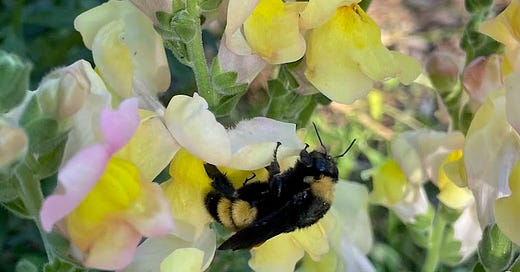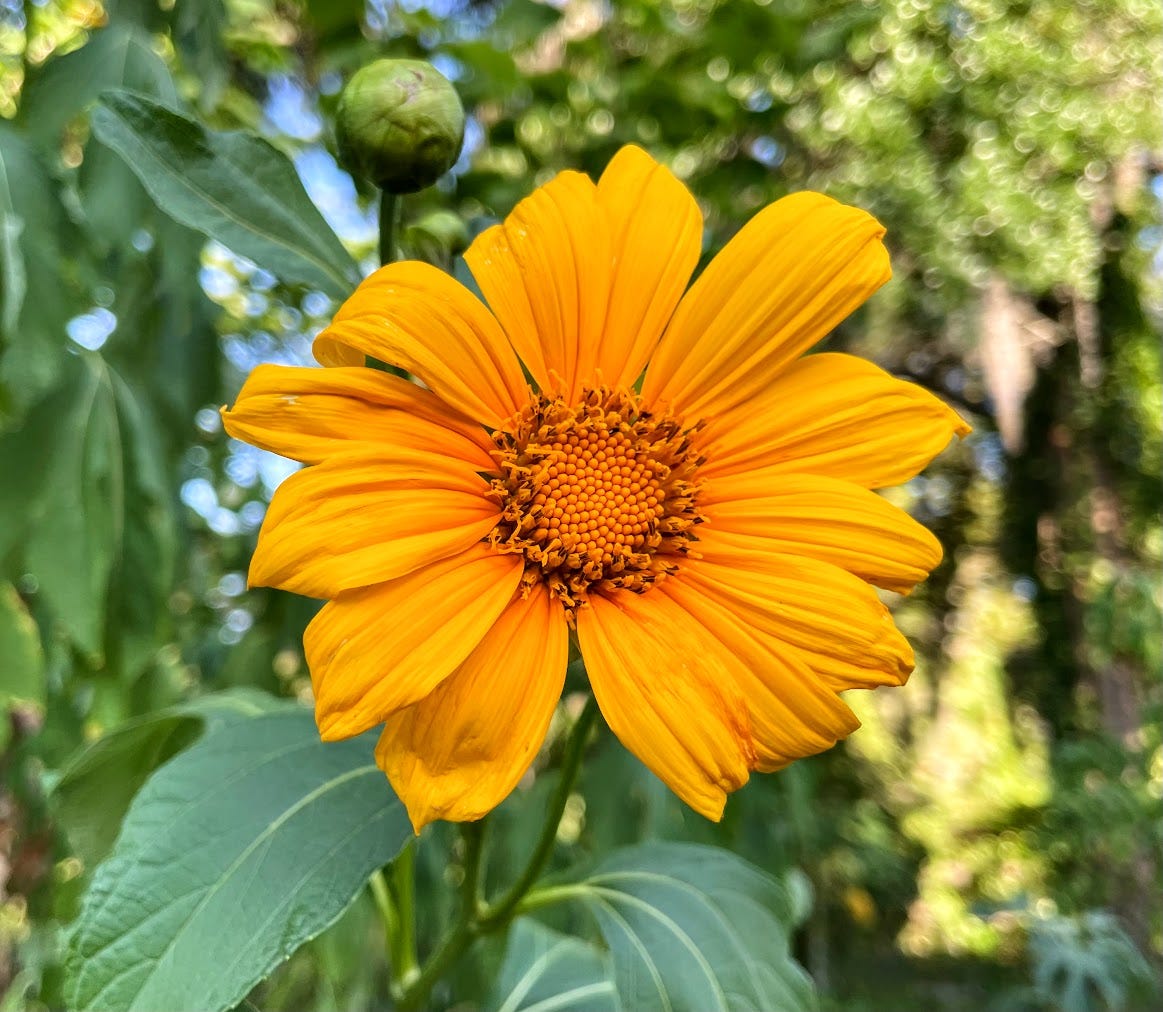Everything is exploding with growth and beauty. We continue to be wowed by the variety of wildlife that our farm supports. We’ve made a point to plant a wide variety of native species and let wildflowers go to seed even if they look a little weedy at times.
This is because a major goal of permaculture is to support vibrant, healthy and diverse ecosystems as well as growing our own food and living a quality life. And these things are very complimentary!
So while we have a wide variety of edible plants in our garden, we also have many “support” plants and structures that not only support food plants, but their pollinators, pest predators and a wide range of diverse wildlife. Doing so allows us to create a balanced ecological system that supports our food plants on deeper levels, a standard result of permaculture design.
As one example of achieving this, we plant flowers in the garden like cosmos and snapdragon that reseed themselves, but also leave patches of wildflowers around the farm, not only because they’re beautiful and many are edible but because of their attractiveness to the native pollinators and pest predators we like to support.
Any time of day, you can find them on these edible and delicately beautiful flowers.
We leave swaths of these on our farm and they bring the pollinators right in. Good survival food that you will never need to care for or cultivate since it will grow just about anywhere. It is also a highly nutritional green and medicinal herb. Because these native and flowering plants have been so clearly beneficial in our systems, we have expanded our offerings of these in our nursery.
Our Nursery
Our farm and nursery are undergoing a transformation and expansion with our new farm managers, Rain and Dominic. We’re excited to offer a wider diversity of plants and will continue to expand those offerings.
One of our favorites is firebush, a perpetually flowering native plant that is a magnet for zebra longwing. We have seen six longwing sipping on the flowers of a single bush at the same time! We also love the passion flower vine, the host plant of the zebra longwing and gulf fritillary butterflies.
Passion flowers have a unique beauty. The leaves of the plant act as a mild sleep aid, and a single vine will produce dozens of delicious fruits! Grow it up a pine tree - when the fruit is ripe it will drop to the ground where you can harvest it easily.
Simpson Stopper bushes are one of our all around favorite native plant. An attractive but tough, drought and frost resistant evergreen bush that can be trimmed into a small accent tree with delicate tiny white flowers that attract literally hundreds of pollinators, and edible berries that birds adore, what is not to love?
This moth is harmless and beautiful. Just one of dozens of types of pollinators that stop to visit these flowers.
If you don’t have Mexican sunflower (Tithonia rotundifolia), you might enjoy its cheerful yellow flowers, its ability to feed the soil for your other plants, and its irresistible attraction for bumblebees and butterflies.
Pollinator, “chop and drop” fertilizer for your garden, hedge, and dramatic beauty. This plant puts out a shock of large yellow flowers 20 feet tall and needs little care.
Native pollinators and other useful plants in your yard help ensure your fruit trees bear abundantly by providing pollinators with regular food and ensuring they visit your food forest regularly. They also feed pest predators who depend on pollen as well as eating your garden pests.
African basil is another staple in our garden, a unique basil that is a short term perennial and never goes to seed. It is perpetually loaded with flowers, offering pollinators food when other flowers are rare. It is low maintenance, drought tolerant and is a great edge plant or companion plant in food forests. We also plant it at the ends of our garden beds.
Add a row or mix of any of these plants to our garden, put some of them at the ends of beds, or use them as accent or guild plants in a food forests. They also make great hedges.
We of course have fruit trees and other edibles as well. We strongly recommend everbearing mulberry trees, something well worth having even in a small yard.
These trees fruit generously twice a year in spring and fall and produce berries that are loaded with antioxidants and other beneficial nutrients. They are also delicious frozen, dried, in jams, syrups, desserts, smoothies, kombuchas and in many other dishes.
Planting now and helping it establish will result in a small fruit crop this fall, and many people get a good fruit crop as early as the next spring if the tree is fed and watered sufficiently.
Dwarf mulberries are small, attractive trees that can easily be trimmed and fruit well in both sun and part shade.
See the nursery for the full selection.
Volunteer days!
Would you like to get some hands-on experience on our farm? We are having a big volunteer event this weekend. We’ll be beautifying, propagating plants, and preparing a swale for planting. Learn as you meet others of like mind and build community.
We start Friday with a plant sale at 4 PM, then yoga, a potluck and celebration by our biochar fire. Saturday morning we’ll have breakfast and then work together on a couple of projects that will be learning opportunities.
If you can’t make it this weekend, we have regular volunteer days every Tuesday and Saturday from 9-noon. We have limited live-in opportunities as well. Working on a permaculture farm, with our garden, food forest and orchard systems, is a great way to learn to do it yourself whether you have a small yard or acreage.
We have a wide range of activities that we do; you’ll have the opportunity to learn a number of skills, or just simply be together in a group of like minded people making something beautiful.
Fill out our volunteer questionnaire to help us get to know you; we’ll try to match our needs with your learning needs and interests where possible.
Events
Check our calendar for more events in May and June, and keep checking back because we’ll be adding some more great events! We have a potluck and farm tour coming in mid-May and a large homesteading event on the first of June as well as different permaculture classes on other weekends.
Permaculture Design Courses
We will offer our well-respected, internationally recognized In-person Permaculture Design Course starting in the fall. It runs for six months, one weekend per month (skipping December).
For those who can’t make an in person course we offer our Online Permaculture Design Course which starts in October. It also runs for six months but can be extended on an individual basis.









